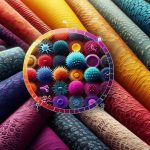If you’re considering fabrics that promise comfort and cleanliness, silver-infused hypoallergenic materials might catch your interest. They offer natural antimicrobial benefits that can keep odors and bacteria at bay, which sounds ideal for sensitive skin or active wear. But before you decide, it’s important to understand the trade-offs involved—like cost, durability, and potential skin reactions—that could influence whether these fabrics are right for you.
Table of Contents
Key Takeaways
- Silver-infused fabrics naturally reduce bacteria, minimizing skin irritation and allergic reactions for sensitive users.
- These fabrics help control odor by inhibiting odor-causing microbes, keeping clothing fresher longer.
- Higher cost and potential silver particle degradation can affect durability and long-term effectiveness.
- Some individuals may still experience sensitivity to silver despite its hypoallergenic properties.
- Common applications include medical textiles, athletic wear, everyday apparel, and home textiles for enhanced hygiene.
Advantages of Silver Infused Hypoallergenic Fabrics
Although you mightn’t notice it immediately, silver infused hypoallergenic fabrics offer significant benefits that improve comfort and health.
When you wear these fabrics, you gain notable health benefits because silver has natural antimicrobial properties that help reduce bacteria on the skin. This action minimizes irritation and allergic reactions, making it ideal for sensitive skin.
Additionally, you’ll appreciate the odor reduction silver provides, as it inhibits the growth of odor-causing microbes. This means your clothing stays fresher longer, even during intense activities or hot weather.
Drawbacks and Limitations to Consider
While silver infused hypoallergenic fabrics offer many benefits, they also come with certain drawbacks you should consider before making a purchase.
One key concern is cost considerations; these fabrics tend to be pricier than traditional options, which mightn’t fit every budget.
Silver-infused fabrics often come with a higher price tag than standard materials, which may not suit all budgets.
Additionally, durability issues can arise over time. The silver particles embedded in the fabric may degrade or wash out after repeated laundering, reducing the fabric’s effectiveness.
You should also be aware that some people might experience sensitivity to silver, despite its hypoallergenic claims.
Finally, although these fabrics resist bacteria, they aren’t a complete safeguard against all allergens or irritants.
Weighing these limitations will help you decide if silver infused fabrics truly meet your needs.
Common Uses and Applications
Understanding the drawbacks of silver infused hypoallergenic fabrics helps you make informed choices about where and how to use them effectively.
These fabrics are popular for their antimicrobial properties and reduced allergic reactions, making them ideal in several key areas.
- Medical Textiles: You’ll find silver infused fabrics in wound dressings, surgical gowns, and hospital bedding to minimize infection risks and promote healing.
- Athletic Wear: These fabrics help control odor and moisture, keeping you comfortable during workouts.
- Everyday Apparel: They’re used in socks, underwear, and activewear to reduce irritation and maintain freshness.
How Silver Infusion Is Incorporated in Fabrics
When you choose silver infused fabrics, it’s helpful to know how manufacturers incorporate silver to assure its benefits. Silver’s unique properties, like antimicrobial action, are preserved through precise fabric treatment methods. Typically, silver is either embedded into fibers during production or applied as a coating after weaving. These methods assure durability and maintain fabric softness while delivering silver’s hypoallergenic advantages.
| Fabric Treatment Method | Description |
|---|---|
| Silver-Coated Fibers | Silver nanoparticles coated on fibers |
| Blended Fibers | Silver mixed with fibers before spinning |
| Surface Coating | Silver applied on finished fabric |
| Microencapsulation | Silver trapped inside microcapsules |
| Ion Exchange | Silver ions bonded chemically to fabric |
Each method balances silver properties with fabric comfort and longevity, so you get effective, lasting results.
Environmental and Economic Impact Analysis
Choosing the right silver infusion method not only affects fabric quality but also impacts the environment and your budget.
When evaluating silver infused hypoallergenic fabrics, consider these factors to balance sustainability practices and cost analysis effectively:
- Resource Consumption: Some infusion techniques use less water and energy, reducing environmental strain and often lowering production costs.
- Durability and Longevity: Fabrics that maintain silver’s efficacy longer mean fewer replacements, benefiting both the planet and your wallet.
- Recycling and Waste Management: Opt for manufacturers prioritizing eco-friendly disposal or recycling of silver particles to minimize toxic waste.
Frequently Asked Questions
How Do Silver Ions in Fabrics Kill Bacteria Without Harming Skin?
You’ll find the silver ion mechanism disrupts bacterial cell walls, killing germs effectively. Its antibacterial properties target bacteria specifically, so it doesn’t harm your skin or cells, making it safe and gentle for regular use.
Can Silver-Infused Fabrics Cause Silver Allergies or Sensitivities?
Ironically, even silver can irritate you—if you have silver allergy symptoms like redness or itching. Don’t guess; get silver sensitivity testing before using silver-infused fabrics to avoid unexpected skin reactions. Stay safe and stylish!
How Does Washing Affect the Antimicrobial Properties of Silver Fabrics?
You’ll find that washing frequency impacts silver fabric’s antimicrobial properties; frequent washing can reduce effectiveness over time. To preserve antimicrobial benefits and extend fabric lifespan, you should follow care instructions and avoid harsh detergents or high temperatures.
Are Silver-Infused Fabrics Safe for Children and Babies?
You can trust silver-infused fabrics for child safety since they offer fabric benefits like antimicrobial protection and hypoallergenic qualities. Just verify the fabric is tested for safety standards to keep your baby comfortable and protected.
What Certifications Verify the Quality of Silver-Infused Textiles?
Think of quality standards as a lighthouse guiding you through stormy seas; certifications like OEKO-TEX and GOTS guarantee textile testing rigor. They guarantee silver-infused fabrics meet safety and eco-friendly benchmarks you can trust every time.
- Recycling Nonwoven Fabrics: Is It Possible? - July 11, 2025
- Recycling Nonwoven Fabrics: Is It Possible? - July 11, 2025
- Recycling Nonwoven Fabrics: Is It Possible? - July 11, 2025







